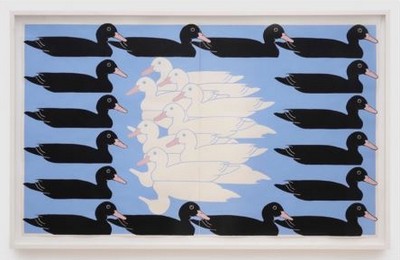John Wesley
WesleyWorld: Works on Paper and Objects 1961–2004
Pace Galley, New York
January 12 – February 24, 2024
Untitled (Ducks), 1983
© John Wesley, courtesy of
The John Wesley Foundation and Pace Gallery
Pace presents its first exhibition dedicated to the work of John Wesley since the gallery began representing his estate in early 2023. This exhibition brings together over 30 works on paper and painted objects produced by John Wesley over the course of his career, from the early 1960s to the early 2000s.
John Wesley, who died in 2022 at age 93, is known for his flattened, idiosyncratic figurations that defy easy classification within any single artistic movement. Drawing inspiration from images in comics and other mass media, the artist cultivated a distinctive, graphic style characterized by bold, weighted lines, unmodulated color, and an absurdist- edge.
Marked by eroticism, wry humor, and often a slight sense of unease, John Wesley’s work explores a wide range of imagery informed by pop cultural and literary sources as well as the artist’s own memories and daily experiences. Many of his works are concerned with enactments of balance and symmetry, examining nuances of sexuality and desire through a formal language characterized by unexpected crispness and precision.
“The puzzling, open-ended ambiguity of Wesley’s depictions encourages expansive gestures of critique, whatever their ultimate merits,” art historian Richard Shiff writes in a newly commissioned essay for Pace Publishing’s digital catalogue accompanying the gallery’s Wesley exhibition. “To a theorist, his art readily demonstrates that interpretation has no limits, for every nuance of graphic difference initiates multiple interpretive threads with the potential to lead just about anywhere.”
John Wesley produced a large body of landscapes regularly depicting tranquil shorelines and stormy seascapes, but also rolling hills and urban skylines. In his figurations, the human body and its constituent parts are often used to experiment with repetition as a formal device. Wesley also frequently reimagined characters from popular culture— most notably Dagwood Bumstead and his wife Blondie from the Blondie comic strip—in scenes across his body of work.
“His often caustic wit also has a warm-heartedness to it when the topic demands, and his sense of comedy is no less pronounced than his sense of tragedy,” art historian Martin Hentschel wrote in his 2005 publication on Wesley’s works on paper, continuing later, “He directed his gaze above all to the human condition, with all its peaks, ambiguities, and abysses.”
A unique voice in the canon of Contemporary art, John Wesley (b. 1928, Los Angeles, California; d. 2022, New York) is known for his precise, lyrical, and often deadpan painterly investigations of the American subconscious. With no formal artistic training, two of Wesley’s jobs had a direct impact on his early practice. At the age of 24, he began working as an illustrator in the Production Engineering Department at Northrop Aircraft in Los Angeles where he translated blueprints into drawings. In 1960, he moved to New York, where he worked as a postal clerk, utilizing symbols such as the shield-like postage stamp and his employee badge in his paintings. Later, his practice expanded to incorporate varied and enigmatic iconographies such as animals, beguiling women, and portraiture of subjects including Theodore Roosevelt, Rudyard Kipling, and Count Henri de Baillet-Latour, the president of the 1932 International Olympic Committee. Through a carefully refined visual vocabulary of clean lines, solid shapes, and repetition, John Wesley imbued everyday scenes and quotidian subjects with humor and wry wit. Exploring themes relating to trauma, eroticism, innocence, and coyness, paintings within his oeuvre are characterized by a linear stylized formation, similar to comic strips, and are often populated with cartoon characters such as Dagwood Bumstead, Popeye, and Olive Oyl. His series, Searching for Bumstead, which he began in 1974 and continued for the entirety of his career, depicts empty interiors—including a vacant armchair, slippers by a bedside, a bathtub filled with water—and is an exploration of the trauma of losing his father, whose sudden death deeply affected him.
John Wesley defies categorization as an artist. During the 1960s, as the tenets of Pop art began to take shape, he was grouped with the movement due to the basic elements of his style and subject matter. Wesley exhibited alongside Pop artists such as Andy Warhol, Tom Wesselman, and Roy Lichtenstein but ultimately eluded true categorization both in theory and in practice due to his unique visual language. His first solo exhibition was at the Robert Elkon Gallery, New York, in 1963. Minimalist artist Donald Judd, a lifelong supporter of the artist, reviewed the paintings in the show: “the forms selected and shapes to which they are unobtrusively altered, the order used, and the small details are humorous and goofy. This becomes a cool, psychological oddness.” John Wesley was given his own room at the Documenta 5 Retrospective at Kassel (1972) and by the mid 70s it became clear that his work lay somewhere between Pop, Surrealism, and Minimalism, though no label ever encapsulated his singular style. John Wesley’s contributions to painting are undeniable. Envisioned by Donald Judd, the largest collection of works by John Wesley, spanning from 1963 to the present, are permanently on view in his eponymous gallery at the Chinati Foundation, Marfa, Texas. His work is held in public collections worldwide including the Hirshhorn Museum and Sculpture Garden, Washington D.C.; Kunstmuseum, Basel; The Museum of Modern Art, New York; Speed Art Museum, Louisville, Kentucky; and the Whitney Museum of American Art, New York, among others.
PACE GALLERY
540 West 25th Street, New York City

